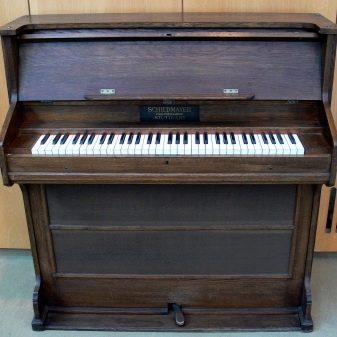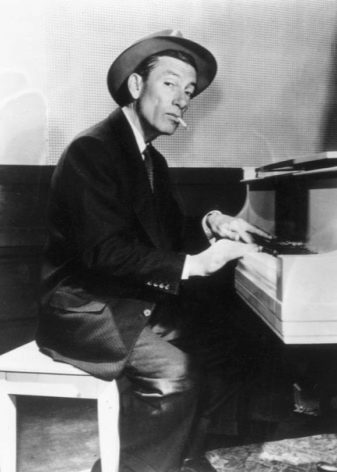Features of celesta

What is celesta, every tenth casual passer-by will answer at best. When polled among non-musicians, the recognition statistics may be as good or even less optimistic. But it's never too late to learn something new, especially if we are talking about such a beautiful instrument with an interesting history.

What it is?
The beautiful Italian word celesta means unearthly. It is with such a romantic word that a keyboard and percussion instrument was named, which is similar to a piano, only small. If you characterize its sound, it will be a pleasant chime of tiny bells. The performer touches the keys of the celesta, and they set the hammers in motion. And already the hammers hit the small steel platforms fixed on the resonators.
Resonators are usually made of wood.

This mechanism repeats the piano device, only simplified. Officially, the celesta becomes a metallophone keyboard. It is compared not only with the piano, but also with the harmonium. It is considered very popular among the complementary instruments of a symphony orchestra.
The design of the celesta enhances the fundamental tones, thereby softening the sound, gaining depth and truly comparable to a melodic bell chime. Czech Antoni Modr said that celesta is something between a grand piano and a bell. He also mentioned the comparison of an instrument with a glass harmonica. Modr also compared the sound of the celesta to the harp.

The instrument has a single pedal, and it plays the same role as the piano pedal. In modern models, it is located to the right of the middle of the case. But the external similarity of the instruments is not everything. The range of celesta is from C to the first octave to the same note of the fifth octave.Today this piece of music is produced by two major brands: the German Schiedmayer and the Japanese Yamaha.


The instrument has a chromatic scale, the notes for it are written in the treble clef (bass prevails) on two staffs, in which the instrument is also similar to the piano. By the way, the question of the celesta's ownership still causes discussion. The same Modr referred it to the group of self-sounding, that is, idiophonic instruments, the sound of which is obtained due to the movement of an elastic material. In musicology, the celesta is considered a percussion keyboard or separately - percussion and keyboard instrument.

Origin story
12 years before the beginning of the 19th century, a London specialist by the name of Klaggett invented the tuning fork clavier, which can be called the "father" of the celesta. He worked like this: hammers hit the tuning forks of different sizes. In the 60s of the same century, Mustel, a Frenchman by origin, made an instrument very reminiscent of such a clavier, it became known as the dulciton. Subsequently, his son Auguste finalized his father's invention: instead of tuning forks, he equipped it with metal plates with resonators. And the new musical object obviously began to resemble a piano, only its sound was like a gentle overflow of bells.

In 1886 the celesta itself was registered. At the intersection of two centuries, an era of popularity awaited her, golden for her. In 1888, in Shakespeare's dramatic work The Tempest, this instrument with the voices of bells was used for the first time, and was popularized by the composer Chausson.

In the XX century, celesta sounded in the works of authorship of Shostakovich, Kalman, Britten, Feldman - names that are in the first row of world classical music. In the 1920s, the celesta also found its place in jazz, and was made famous by the performers Hogi Carmichael, Art Tatum and Oscar Peterson. A decade later, jazzman Fats Waller managed to demonstrate an unusual technique of playing the celesta, more precisely, on two related instruments at once, because Waller played the piano with his left hand.


Our celesta also did not go unnoticed. Pyotr Ilyich Tchaikovsky heard its sound in 1891 at one of the Parisian concerts. The instrument fascinated Tchaikovsky, and he decided to bring it home. And in 1892, at the premiere at the legendary Mariinsky Theater - at the performance The Nutcracker, which has already become a legend in world music - the celesta sounded.
For the first time in Russia - and immediately in such a great work!

The sound of the celesta was incredibly accurate and convincing in that moment of the ballet when the Sugar Plum Fairy enters the stage. The instrument even seemed to transmit falling water droplets. Celesta also found a place in such works as "A Midsummer Night's Dream" by Britten, "Distant Ringing" by Shecker, Suite "Planet" by Holst, opera "Akhenaten" by Glass, etc.

Sound features
Hoffmann said that music comes to the rescue when it is impossible to express something in ordinary words. Celesta is an example of an instrument whose sound is very expressive, memorable, piercing. Lots of little bells are talking to each other - you can't put it more precisely. This is always associated with magic, a fairy tale, the creation of an atmosphere that really mesmerizes and takes the listener into that wonderful distance that the composer created.

They also compare the instrument with the sound of crystal. As if the same fairy takes a silver spoon and gently hits the crystal legs of wine glasses or vases. This is how celesta sounds - heartfelt, subtle, bewitching. Perhaps, there is nothing better than a variation of the Sugar Plum Fairy to get acquainted with the instrument and be fascinated by it.

Application
Celesta is most actively used in academic music. Having become part of the cult works, she has already registered her name in musical history. In the work "The Sea" by Claude Debussy, celesta also sounds, as it appears in "An American in Paris" by the great Gershwin. And how not to mention the sound of many clean bells in the legendary "City Lights" by Charlie Chaplin or in "Pinocchio" by Paul Smith. The melodic, romantic celesta was especially fond of the American John William, who wrote music for films.

Buddy Holly, The Beatles, The Beach Boys, Pink Floid - these are the groups (some of) that made celesta the voice of rock compositions too. Recognizing the instrument in the hits of cult bands is a special pleasure for a music lover.


It can be a soloist or be one of the voices of the orchestra, it can become consonance in the general choir or come to the fore - lyrical, touching. The instrument can hardly be called exotic, because it still exists today, is used by musicians, and is repeated in the most famous hits of world music. But to play it for themselves, at home, is the lot of units who are attracted by such, nevertheless, relatively rare instruments. But those who are fascinated by the piano and attracted by everything unusual may not stop in front of this exclusivity and conquer another instrument.
He can definitely become the most touching in the overall collection.










Can the entire orchestra be tuned by celesta?